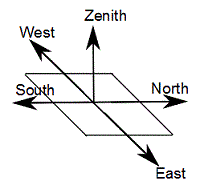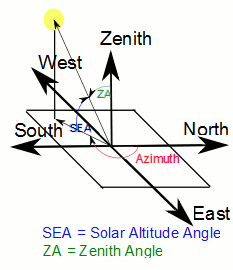This page is one of three introducing insolation-concepts. An overview is at insolation. The other two pages are: insolation definitions and types of radiation.

This page defines some terms that are often used when discussing solar energy. After defining "solar radiation" and "insolation", we differentiate between "irradiance" and "irradiation."
We then explain how we'll be using "solar intensity" on all of our insolation pages.
Finally, we explain the difference between "solar elevation angle", "zenith angle" and "solar azimuth angle".
Solar radiation is electromagnetic radiation made by the sun.
What exactly that is is complicated. For our purposes, we just need to remember that electromagnetic radiation is a type of energy that can move through empty space.
"Solar radiation" is sometimes thought of in terms of "energy" and sometimes in terms of "power".
"Power" is "the rate of energy transfer" - how quickly energy is transferring
from one thing to another.
Insolation measures solar radiation per unit area (the density of the solar radiation - how much of it is falling on or has fallen on a square meter, square foot or etc). As we discuss below, this measurement of solar radiation is sometimes given in terms of "energy" and sometimes in terms of "power".

Sometimes people use "insolation" to describe the sunlight's power per unit area at a given place in a given instant. When this is the case, "insolation" is measured in watts per square meter (W/m2) and can track moment-to-moment changes in the strength of the sunlight.
Other times when people say "insolation" they are talking instead about how much solar energy per unit area a place receives over some period of time.
In this second case, "insolation" is measured in kilowatt-hours per square meter (kWh/m2) and is used to discuss how much solar energy a place receives in a day, a month, a year, or etc.
Since "insolation" is often used to describe either power or energy, people sometimes use more exacting terms when they want to be extra careful.
If you want to make sure that people know you are describing the strength (power) of the sunlight on your nose right this moment, say "irradiance". If you want to be certain everyone knows that you are talking about how much total solar energy your nose absorbed yesterday, say "irradiation".1

People often use solar intensity or just "the intensity of the sunlight" or even "the strength of the sunlight" as synonyms for irradiance. We will be adopting that strategy for this website. "Intensity" and "strength" are more common words and they capture the sense of "irradiance" well.
If, in a given moment, a very high number of watts of solar radiation are striking a square meter, the sun will feel very intense/strong to someone standing in that square meter.
Since irradiation is a measurement of energy accumulated over some period of time, it isn't an instantaneous measurement and so it doesn't have quite the same connotation as "intensity" or "strength" - at least not to me.
On this website, we use "solar angle" or "sun angle" when we just want to talk in general about the vertical angle of the sun in the sky (how high it is in the sky).
If we want to say exactly how high the sun is in the sky, we will use either "solar elevation angle" (SEA°) or "zenith angle" (ZA°). If we are talking about the horizontal angle of the sun (where along the horizon it is), we use "azimuth angle". The diagrams below should help to illustrate these concepts.
Before we introduce the angles, we quickly introduce the concept of "zenith" as not everyone is familiar with it.


Besides keeping track of "North, South, East and West", we sometimes need to pay attention to the zenith direction - the direction directly overhead of you. To see it you have to crane your head back and look straight up. The zenith is always 90° above the horizon.
To communicate how high the sun is in the sky, people often tell you the "solar elevation angle". This is how many degrees above the horizon the center of the sun is.
They can communicate the same information with reference to the zenith. The "zenith angle" is how many degrees below the zenith the center of the sun is (how far below "directly overhead" the sun is). The diagram should help make these definitions clear.
Note that because the solar elevation angle (SEA) takes the horizon as its reference and the zenith angle (ZA) takes the zenith as its reference point and because the zenith is always 90 degrees above the horizon, SEA° + ZA° = 90.°
That means if we know the zenith angle and want to know the solar elevation
angle, we can just use this formula:
90° - ZA° = SEA°.
The "solar azimuth angle" (Azimuth) measures the horizontal angle of the sun along the horizon (as opposed to the vertical angle of the sun above the horizon which is what "solar elevation angle" measures).
The convention is to measure the solar azimuth clockwise starting from due North. So, due North is "0°" or "360°", due East is "90°", due South is "180°" and due West is "270°."
1. The concepts behind the definitions for "irradiance" and "irradiation" come from the website of
Volker Quasching, an author of books and articles in the renewable energy field. The page is:
fundamentals.
Hey!
We never interupt content with ads.
How rare and cool is that these days?!
Help us keep it that way by using the share button below:
The "not-interrupting-content-as-promised", side links below are not paid ads. They are personal recommendations from David Watson, who is wise and thoughtful:

Visit B Willard's
Lonesome Design Shop

